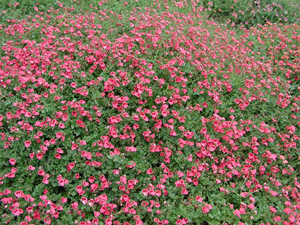Resource Library
Plant of the Week: Twinspur, Diascia
The University of Arkansas System Division of Agriculture does not promote, support or recommend plants featured in "Plant of the Week." Please consult your local Extension office for plants suitable for your region.
Plant of the Week
Twinspur
Latin: Diascia hybrid

With the explosion of new garden plants during the last two decades, I must admit to being slow to recognize the garden merits of some of them. One of these I missed is twinspur (Diascia hybrid), a showy but smallish annual that has exploded in popularity during the last decade.
There are 70 species of Diascia, all of which are native of South Africa, which belong to the snapdragon family. Most of the 50 or so annual Diascia are found in the Western Cape and Namaqualand Provinces in the winter-rainfall zone. The perennial sorts are in the higher Drakensberg Mountains in the summer-rainfall region.
The annual Diascia are spreading bedding plants growing 6 to 8 inches tall and perhaps as much as 2 feet wide. They have clean bright green foliage topped with – depending on the cultivar being grown – coral, salmon, pink, orange, reddish, and even white flowers. The flowers are tubular with five lobes, the largest of which is the lowest petal. The two adjacent lobes immediately above large lower lobe each produce a quarter-inch long nectary spur which gives rise to the common name.
Diascia was introduced into England in the 1870s but was largely dismissed as an insignificant annual. In the 1980s, two botanists undertook a comprehensive study of the genus and, in the process, introduced a number of species into Great Britain. These were distributed to various botanic gardens and were soon discovered by Hector Harrison, the plantsman who created, beginning in 1985, the first widely available commercial hybrids.
Soon afterwards breeders in Netherlands, Israel, Australia and England began breeding efforts and started exploring the many possibilities of hybridizing such a diverse group of plants. Most of the modern hybrids used Diascia barberae as a starting point in their breeding programs. Commercially available Diascia are cutting propagated hybrids introduced by the various plant marketing firms and most did not show up in the U.S. market until about 2005.
Seed production in Diascia is problematic because the species has co-evolved with a group of bees with long forelegs that pollinate the flowers as they use their specially modified legs to extract droplets of oil held in the two floral spurs. In the garden this is a good thing because seed set shuts down flowering.
Diascia are springtime bedding plants that do best until the really hot weather of summer arrives. Though they will tolerate light frosts in early spring, they cannot be planted out in the fall like pansies. Cutting the plants back in the summer when heat stops their flowering may set them up for a second blooming cycle in the fall when cooler weather arrives again. Diascia are best in full sun with typical garden maintenance given to most annual plants. They are also well suited for container, window box and hanging basket use, but to keep them flowering an ongoing fertilization program should be used.
Most of the excitement about twinspurs has been about the annual kinds, but at least one cold-hardy selection – Diascia integerrima ‘Coral Canyon’, developed by Denver Botanical Garden plant guru Panayoti Kelaidis – has done well at the Botanical Garden of the Ozarks.
By: Gerald Klingaman, retired
Retired Extension Horticulturist - Ornamentals
Extension News - July 27, 2012
The University of Arkansas System Division of Agriculture does not maintain lists of retail outlets where these plants can be purchased. Please check your local nursery or other retail outlets to ask about the availability of these plants for your growing area.